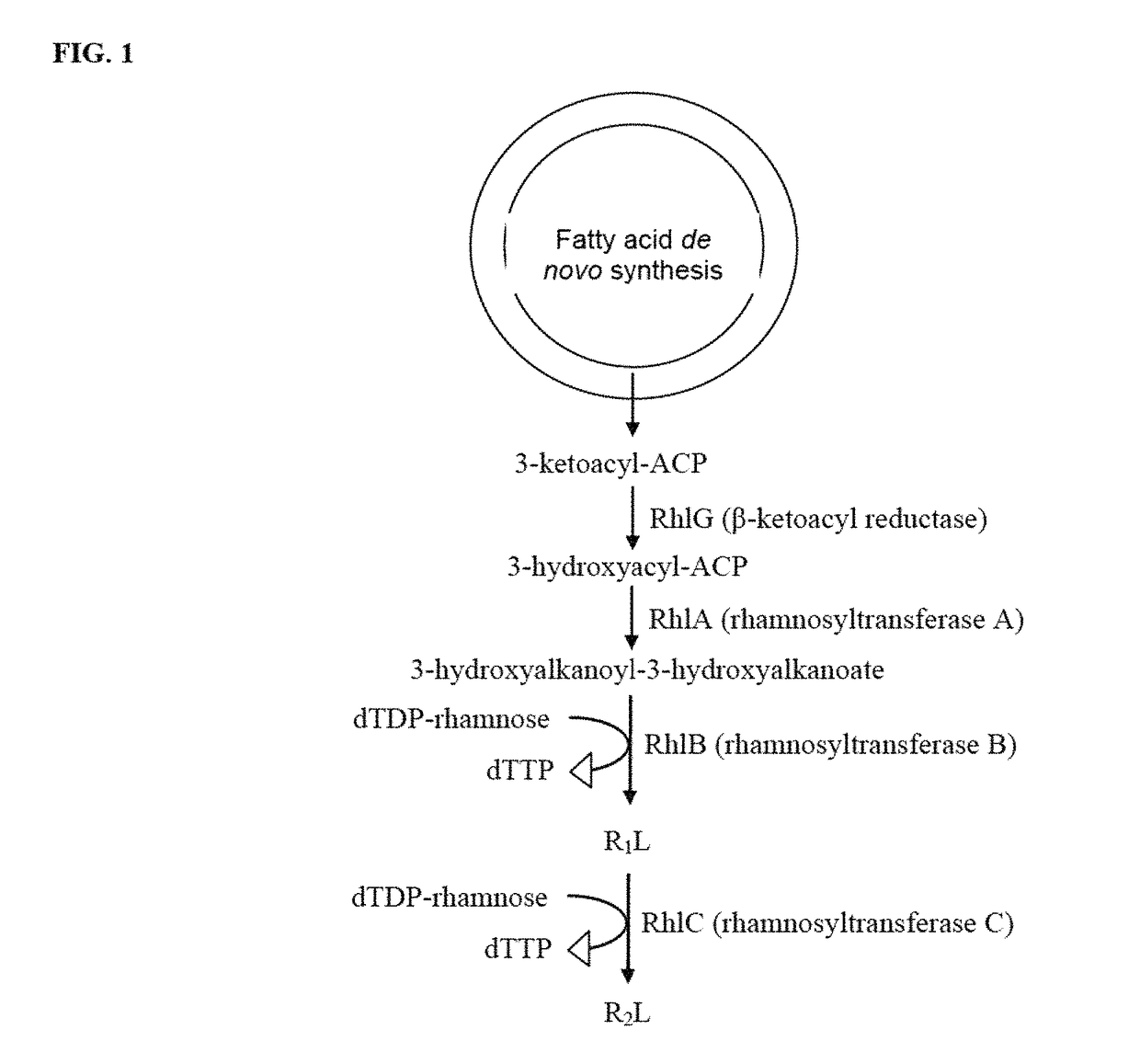Production of dirhamnose-lipid in recombinant nonpathogenic bacterium Pseudomonas chlororaphis
a technology of dirhamnose-lipid and recombinant nonpathogenic bacteria, which is applied in the direction of enzymology, peptides, transferases, etc., can solve the problem of leaving unanswered questions
- Summary
- Abstract
- Description
- Claims
- Application Information
AI Technical Summary
Benefits of technology
Problems solved by technology
Method used
Image
Examples
example 1
Cloning and Characterization of rhlA, rhlB, and rhlR
[0125]Pseudomonas chlororaphis NRRL B-30761 is a non-pathogenic organism that produces monorhamnolipids (R1L) (U.S. Pat. No. 7,202,063). Genetic characterization of this strain is undertaken to facilitate metabolic engineering effort to improve its rhamnolipid biosynthesis potential both in terms of product yield and structural variety. The genes responsible for R1L synthesis, rhamnosyltransferase A and B (rhlA and rhlB, respectively) are cloned and characterized using a PCR approach described previously (Solaiman 2000. Biotechnol. Lett. 22:789-794; Solaiman, et al. 2008, J. of Industrial Microbiology and Biotechnology 35:111-120). Prior to initiating cloning of rhlA and rhlB, sequence alignment analysis is performed on the reported sequences of rhlA and rhlB of Burkholderia pseudomallei K96243 (gi 53721039), Burkholderia mallei ATCC 23344 (gi 53715870), Pseudomonas aeruginosa PAO1 (gi 15595198), P. aeruginosa PAO1 (gi 9949611) and...
example 5
Chromatographic Separation of Rhamnolipid, LC / MS Determination, and Tensiometric Measurement
[0140]To quantify the relative amounts of R2L and R1L that were produced, one must physically separate and weigh them. While a technique such as LC / MS can in principle provide equivalent information, if the sample is a complicated mixture of many compounds, as these are, baseline separation and integration of peaks may be difficult to achieve. Separation using silica gel chromatography is feasible to perform. The crude material obtained by ethanol / chloroform extraction (see Example 4 above) is dissolved in 90:10 chloroform / methanol and is applied to a column of 50 g silica (Fisher Scientific; Fairlawn, N.J.) that is packed with the same solvent. Elution with this solvent affords a non-polar fraction which is not characterized or identified. Monorhamnolipids, including R1L, are eluted next from the column by adding a more polar solvent mixture of 80 / 20 / 1 chloroform / methanol / water (solvent A) t...
PUM
| Property | Measurement | Unit |
|---|---|---|
| Tm | aaaaa | aaaaa |
| temperature | aaaaa | aaaaa |
| temperature | aaaaa | aaaaa |
Abstract
Description
Claims
Application Information
 Login to View More
Login to View More - R&D
- Intellectual Property
- Life Sciences
- Materials
- Tech Scout
- Unparalleled Data Quality
- Higher Quality Content
- 60% Fewer Hallucinations
Browse by: Latest US Patents, China's latest patents, Technical Efficacy Thesaurus, Application Domain, Technology Topic, Popular Technical Reports.
© 2025 PatSnap. All rights reserved.Legal|Privacy policy|Modern Slavery Act Transparency Statement|Sitemap|About US| Contact US: help@patsnap.com



